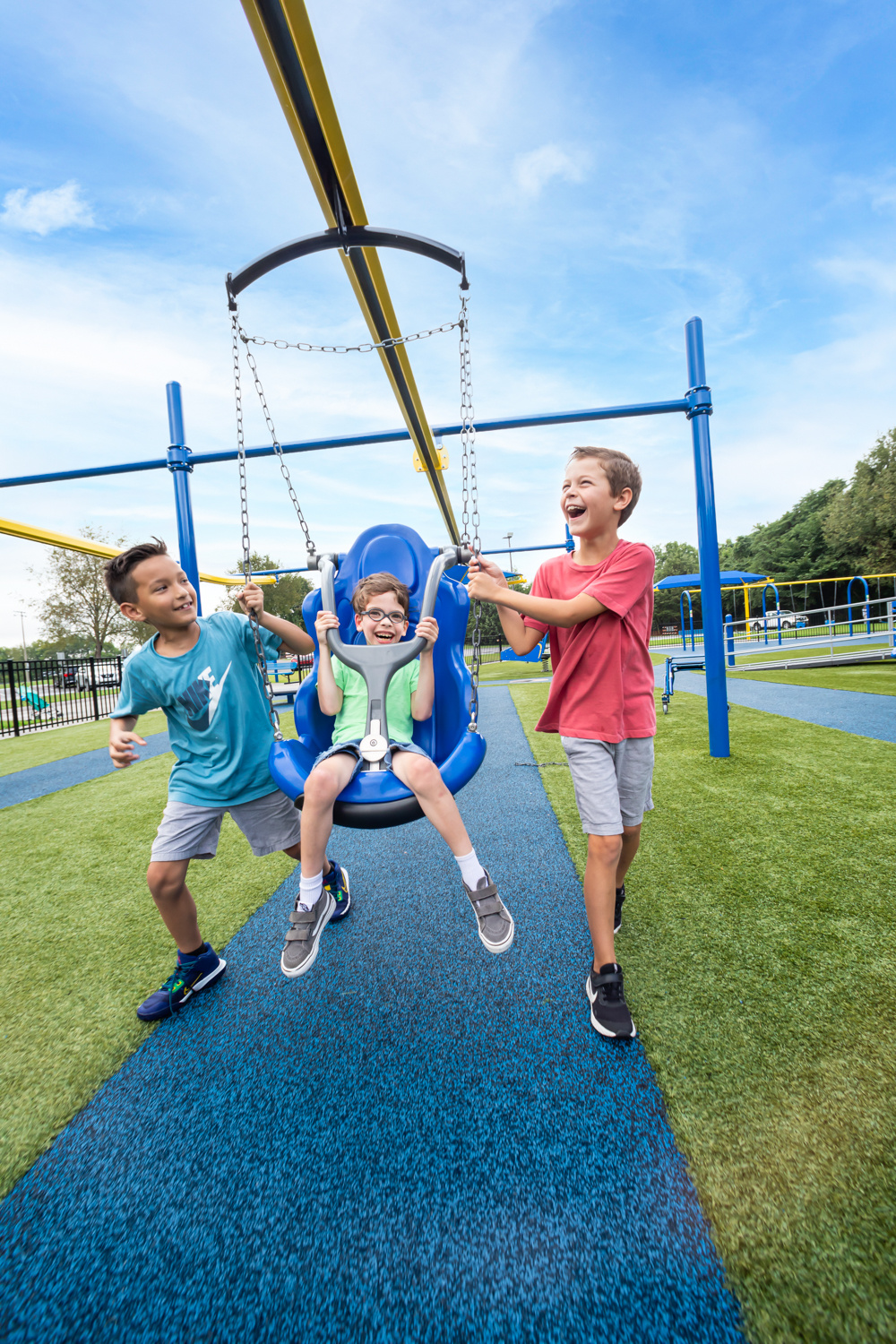Inclusive Playgrounds: The Ultimate Guide to Creating Play Spaces
Posted by May Recreation Content Team on

Imagine a playground where every child, regardless of ability, can laugh, play, and grow together. Now imagine being left out of that invaluable experience.
“Do you remember spending afternoons swinging high into the sky, dreaming of life’s possibilities? Or speeding down the slide to catch up with a friend? Many of us look back fondly to the days when life revolved around the playground. It’s heartbreaking to think some kids have not had the opportunity to play on a swing, slide or climb at the park with friends,” says Miracle Recreation.
This is the essence of an inclusive playground – a thoughtfully designed space that welcomes children of all abilities, fostering a sense of belonging and joy.
“An inclusive playground exceeds ADA regulations and allows children of all abilities and developmental stages to play together. By designing an inclusive playground, you create a nurturing environment for all,” says Miracle Recreation.
At May Rec, with over 25 years of expertise in playground design, we're passionate about creating these inclusive havens that enrich communities and change lives.
The Power of Inclusive Play: More Than Just Fun
Inclusive playgrounds are not just about accessibility; they're about creating opportunities for all children to develop crucial skills:
- Social Integration: These spaces encourage interaction between children of different abilities, breaking down barriers and fostering empathy.
- Physical Development: Adaptive equipment allows children with disabilities to engage in physical play, improving motor skills and strength.
- Cognitive Growth: Sensory-rich environments stimulate brain development for all children, especially those with cognitive disabilities.
According to the Centers for Disease Control and Prevention (CDC), about 1 in 6 children aged 3-17 years have one or more developmental disabilities, such as autism, a learning disorder, or attention-deficit/hyperactivity disorder. Inclusive playgrounds ensure these children don't miss out on the critical developmental benefits of play.
Essential Elements of an Inclusive Playground
An inclusive playground is a place where children of all abilities can play together. Here are some essential elements to consider:
- Accessible Surfacing and Pathways
- Smooth, firm surfaces that accommodate wheelchairs and walkers.
- Wide pathways with gentle slopes for easy navigation.
- Ensure that the playground surface is level and free of obstacles.
- Sensory Play Stations
- Tactile panels with various textures.
- Musical elements for auditory stimulation.
- Colorful, visually engaging equipment.
- Inclusive Swing Designs
- Bucket seats with harnesses for extra support.
- Face-to-face swings for social interaction.
- Wheelchair-accessible swings.
- Wheelchair-Accessible Equipment
- Ramps leading to elevated play structures.
- Transfer stations for easy movement from wheelchairs to equipment.
- Ground-level play elements.
- Quiet Zones
- Cozy corners or small enclosures for children who need a break from stimulation.
- Calming elements like spinning wheels or sand play.
“You can easily make any playground more accessible and inclusive. It may be a matter of adding a few new pieces of equipment to make a playground for people of all abilities,” says Miracle Recreation.
Designing for Diverse Abilities
If you are designing a new playground then you have the potential to design it for diverse abilities, creating spaces that are welcoming and inclusive for everyone.
“While inclusive playgrounds are not a legal requirement, they offer many benefits to your community. Providing opportunities for children to play together helps foster teamwork, acceptance and social skills — the qualities that make for well-rounded kids,” says Miracle Recreation.
When designing your playground for diverse abilities here are some elements to keep in mind:
Physical Disabilities
- Incorporate equipment that can be accessed without steps
- Include hand-held supports and transfer points
Visual Impairments
- Use high-contrast colors and tactile guides
- Incorporate Braille signage and audio elements
Hearing Impairments
- Install visual cues and sign language boards
- Create open sightlines for easier communication
Cognitive and Developmental Disabilities
- Provide clear, simple layouts to prevent overwhelming experiences
- Include equipment that encourages turn-taking and social interaction
Sensory Processing Disorders
- Offer a mix of high-energy and low-key play areas
- Include equipment with various textures and sensory experiences
Remember, inclusive playgrounds can provide valuable educational experiences, teaching children about diversity and acceptance.
Creating a Truly Inclusive Environment
Of course, a truly inclusive environment considers the full playground experience and so designers will want to incorporate shade, water features and inclusive seating into their plans.
These are some of the things that help create a truly inclusive environment:
Shade, Seating and Water Features
- Ample shaded areas to protect from sun exposure.
- Comfortable seating for caregivers, positioned for easy supervision.
- Incorporate water features for cooling and enjoyment.
Clear Communication
- Easy-to-read signage with pictograms.
- Communication boards to assist non-verbal children.
Safety First
- Fencing to prevent wandering.
- Soft, impact-absorbing surfaces throughout.
Community Involvement
- Engage local disability groups in the design process.
- Host community meetings to gather input and build support.
Funding Your Inclusive Playground
The dream of an inclusive playground does not come without an investment but there is help available.
“If you’re concerned about budget, know there is plenty of financial assistance available to help you make your dream a reality. Many organizations support inclusive and accessible playgrounds and are happy to help and contribute some of their resources,” says Miracle Recreation.
Here are some avenues to help fund your inclusive playground:
Grants and Fundraising
- Research federal and state grants for accessibility projects.
- Organize community fundraisers like fun runs or auctions.
Local Partnerships
- Collaborate with businesses for sponsorships.
- Partner with disability advocacy groups for support and resources.
- Connect with community leaders and local caregivers to help your cause.
- Contact local media, both traditional such as your local newspaper and digital sources such as NextDoor, Facebook and other apps, to publicize your need for funds.
May Rec's Support
- Expert guidance on cost-effective, inclusive designs.
- Assistance with grant applications and fundraising strategies.
May Rec Can Bring Your Inclusive Playground to Life
Creating an inclusive playground is a powerful way to build a more accepting, accessible community. Here's how May Rec suggests you can accomplish your inclusive playground goal in five steps:
- Assess Your Community's Needs: Conduct surveys and meet with local disability groups to understand specific requirements.
- Partner with Experts: Collaborate with May Rec's experienced designers to create a customized, inclusive playground plan.
- Secure Funding: Utilize our resources and partnerships to find grants and fundraising opportunities.
- Engage the Community: Involve local residents in the design and building process to create a sense of ownership.
- Build and Celebrate: Work with our expert installers to bring your vision to life, ensuring all safety standards are met.
At May Rec, we're committed to helping you create a playground that's not just a place to play, but a space where all children can thrive.
Contact May Rec today to help design and install an inclusive playground that will meet the needs of your entire community.
